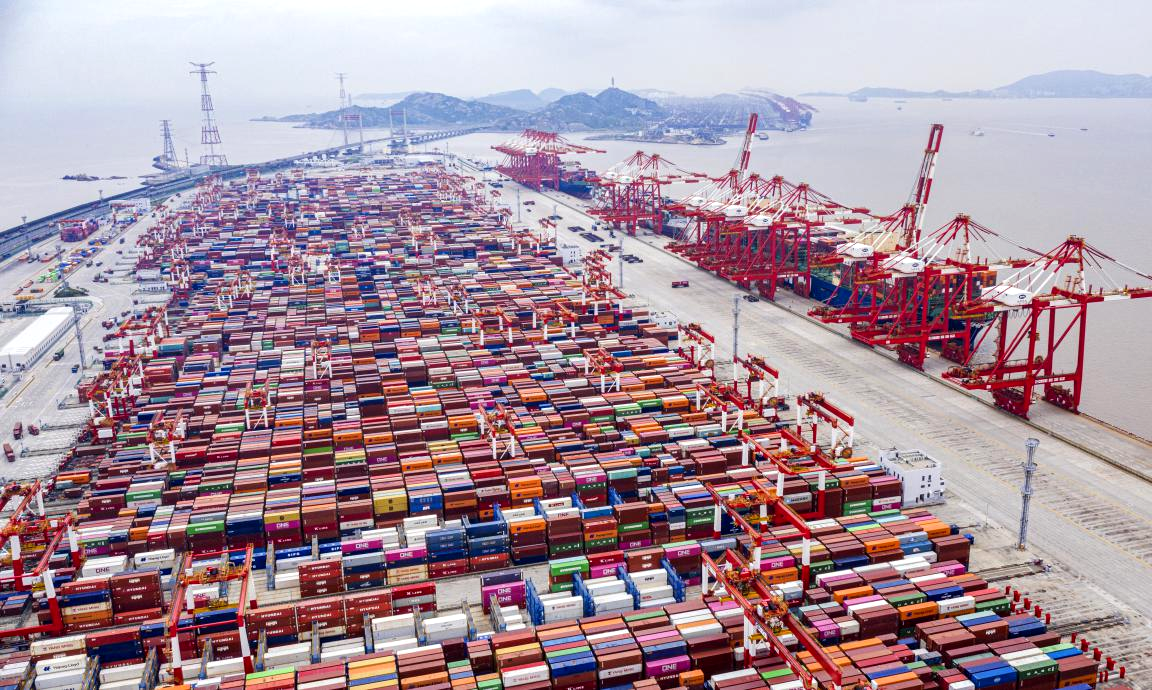Beijing — China’s economy likely expanded at the slowest pace in a year during the third quarter, signaling that the world’s second largest economy continues to lose momentum even as exports surge, according to analysts and preliminary government data.
Economists expect gross domestic product to have risen 4.7 percent in the three months through September compared with a year earlier, down from 5.2 percent in the previous quarter. The National Bureau of Statistics is scheduled to release the official figures on Monday.
The slowdown highlights growing structural pressures on China’s economic model and comes just days before the Communist Party’s key policy meeting, where leaders are expected to chart the country’s direction for the next five years.
China’s post pandemic recovery has been uneven, marked by soft consumer demand, a deep property crisis, and weak private sector confidence.
While foreign demand has bolstered exports pushing the trade surplus to a record $875 billion this year domestic activity continues to lag.
Retail sales are forecast to have increased only 3 percent in September, the weakest pace this year, while industrial output is expected to rise 5 percent, also the lowest of 2025.
Investment remains a key concern. Fixed-asset investment in the first nine months of the year is projected to show no change from the same period a year ago, a sharp contrast to the state led spending surges of previous decades.
“The data show the China economy slowdown is no longer cyclical it’s structural,” said Chen Yong, an economist at the Shanghai Institute for Economic Research.
“Manufacturing, housing, and local government finances are all under pressure, and the old playbook of infrastructure spending is losing effectiveness.”
Despite record overseas shipments of electronics, machinery, and green technology, China’s broader growth engines appear to be sputtering.
Government borrowing and public investment have expanded sharply since May, but local authorities remain burdened by debt and declining land revenues. Analysts say much of the stimulus has failed to reach consumers or smaller businesses.
“Exports have kept factories running, but the benefits are concentrated in a few coastal provinces,” said Li Mei, a trade analyst in Shenzhen.
“Inland cities and smaller enterprises are not feeling the same lift. The China economy slowdown is visible in weaker job creation and stagnant wages.”
Foreign direct investment has fallen nearly 13 percent so far this year, according to official data, putting China on track for its third consecutive annual decline.
Many global firms have scaled back expansion plans amid geopolitical uncertainty and new US technology restrictions.
Economists say the current downturn differs sharply from the short term slowdowns of the past. During the 2015 stock market crash and the 2020 pandemic, Beijing deployed aggressive credit expansion to reignite growth.
This time, officials appear more cautious, wary of fueling asset bubbles or worsening debt risks.
Bloomberg Economics noted that “Beijing now faces deep structural headwinds from fading growth drivers to a protracted property downturn and entrenched deflation unlike the severe yet temporary shocks of the pandemic era.”
The slowdown has also affected confidence in China’s labor market. Youth unemployment officially unreported since mid 2023 remains a sensitive topic. Independent analysts estimate that one in five young workers in cities remain jobless or underemployed.
“The reality is that China’s transition from an investment heavy economy to a consumer driven one is proving painful,” said Wang Zhen, a Beijing based economist. “The China economy slowdown reflects that policymakers can no longer rely solely on exports and construction.”
In the industrial hub of Guangzhou, factory owner Huang Tao said his order books remain full but profits have thinned.
“We’re exporting more than ever, but costs are rising and domestic sales are almost flat,” he said. “I’ve had to cut bonuses for my workers this year.”
Meanwhile, in the inland province of Henan, small business owner Liu Yan said local customers are spending less. “People are cautious. Even during the holiday season, foot traffic was slow,” she said. “Everyone talks about saving instead of buying.”
Retailers across urban centers have echoed similar concerns. Shopping malls in Beijing and Shanghai report fewer luxury sales and more discount driven spending.
Economists say that household sentiment has yet to recover from the pandemic era restrictions and ongoing property market slump.
The Communist Party’s upcoming Fourth Plenum, expected next week in Beijing, will provide clues on how leaders plan to steer the economy between now and 2030.
Officials are under pressure to outline credible reforms to stimulate domestic demand while containing financial risks.
The plenum is also expected to reaffirm President Xi Jinping’s emphasis on “high quality development” and technological self reliance.
“The government will likely prioritize gradual stimulus, targeted at households and new industries such as electric vehicles and AI manufacturing,” said Sun Lijun, a former policy adviser at the Ministry of Commerce.
“But major structural shifts such as reducing reliance on property will take years to materialize.” International investors will be watching closely. A sustained China economy slowdown could ripple across Asia, lowering commodity prices and weighing on regional growth.
The International Monetary Fund recently trimmed its forecast for China’s 2025 expansion to 4.6 percent, warning that “weak domestic confidence and ongoing property stress” remain key risks.
China’s policymakers face a delicate balance: reviving confidence without reigniting debt risks or inflation. For now, the country’s export boom has masked deeper weaknesses in household demand and private investment.
Analysts expect moderate stimulus measures but no large scale rescue plans, as Beijing prioritizes long term economic stability over short term boosts.
“The era of double digit growth is gone,” said economist Wang Zhen. “China must adapt to a slower, more sustainable pace one that reflects the reality of an aging population, technological competition, and shifting global trade patterns.”

